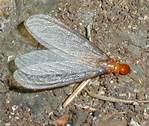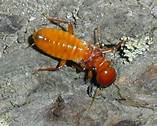- Almost 40 years in business
- Honest, pleasant phone personnel
- GOOD pricing
- Quick turnaround
- Up-to-date techniques
- ASHI Trained Inspectors
- AHIT Schooling
Serving the entire Bay Area, San Joaquin Valley and beyond
- 1. Property inspections
- 2. Termite inspections
- 3. Large and small apartment buildings
- 4. Commercial properties
- 5. Chemical treatment
- 6. Single family homes
- 7. Affordable inspections
- 8. Bundled inspections
- 9. Real estate transactions
Home Inspection Reports
Our home inspections are very detailed with pictures throughout the report. Here is an example of one of our electrical findings.
SAFETY ISSUE: This building is equipped with a main panel and sub panel. In a downstream sub-panel, the white neutral and the equipment ground must not be bonded together. The neutral must be insulated from contacting the metal enclosure and any equipment grounds, bonding these conductors is a hazardous because it creates another path for current. We recommend contacting a licensed electrical contractor for evaluation and repair.
Our home inspections come with a summary of the report. Here is an example.
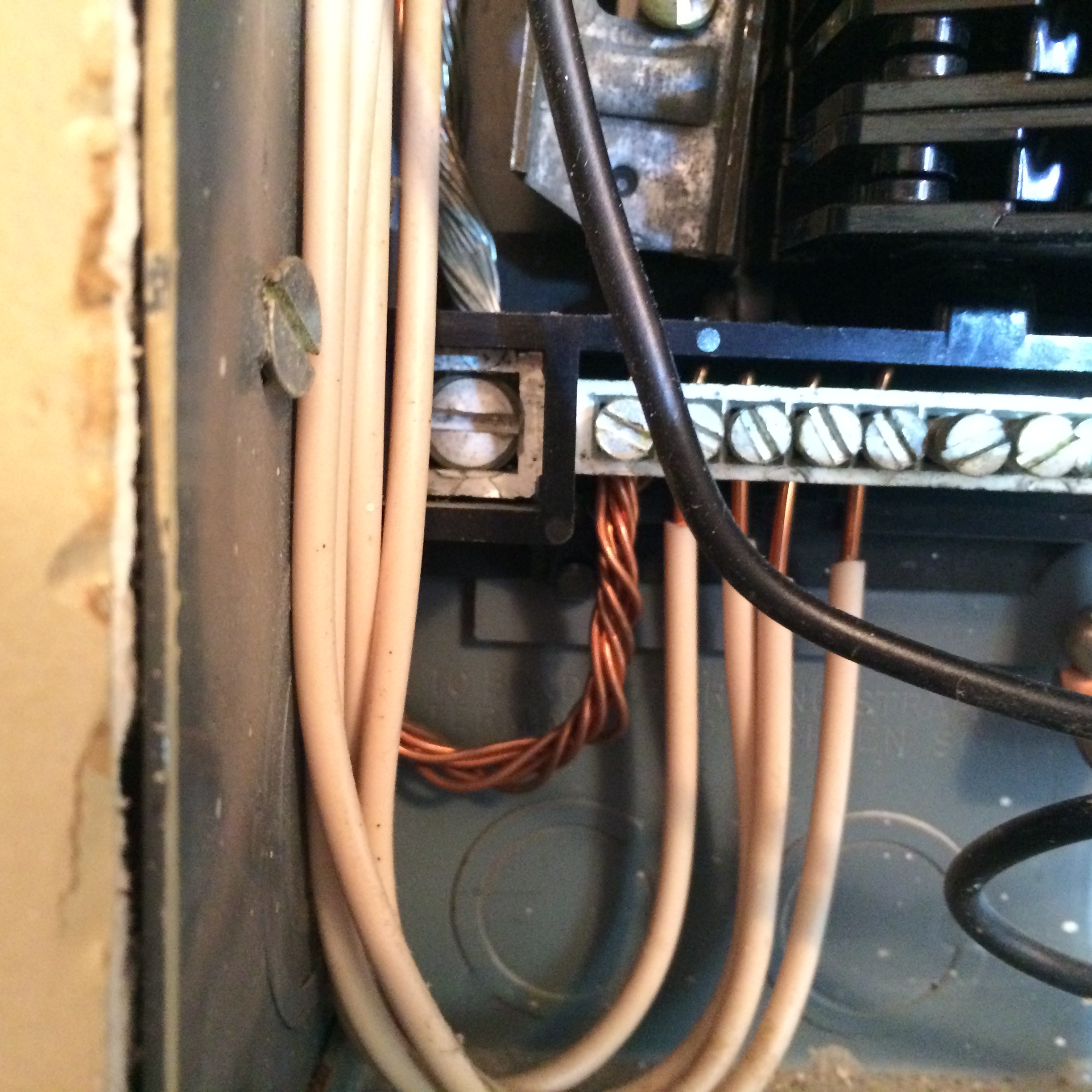
Summary Of Deficiencies
Section 2: Exteriors
1. Further Inspection: Exterior stucco is even with, or extends below, the exterior grade. This condition could conceal and contribute to wood destroying organism infestation. No evidence of infestation or infection was found at this time. We recommend if requested, after concealed areas have been exposed by the owner, we will return to inspect these areas.
2. Repair: The water heater door and jambs are damaged. We recommend repairing the jambs and replacement of the door.
3. Repair: There are rafter tails that have been cut and not repaired correctly. We recommend correct repair by a licensed carpenter.
4. Improve: There are various plants and or bushes next to the exterior wall(s). Recommendation: Trim or prune all vegetation in such a way as to allow a minimum of six inches of clearance between the plant and the exterior wall. This is necessary in order to prevent damage to the exterior and to inhibit the ability of insects to migrate into the building structure.
5. Repair: The patio has cracks that should be sealed. By sealing the cracks moisture will not keep seeping under these areas and cause the cracks to widen. If the cracks are not sealed it will increase the damage of the walkway.
6. Safety Issue: The baluster spacing at the perimeter of the walkways are too wide. It's possible for a small child to slip through the railing and fall. Current codes specify that baluster spacing can be no more than 4 inches wide. Even though this requirement may not have existed at the time this property was built, or the local municipality may never have adopted it, I consider this to be a life/safety issue, and feel it would be prudent to bring the baluster spacing up to current code. A competent carpenter that specializes in decks should be consulted to discuss options and cost.
Section 3: Roof Coverings
1. Repair: Some damaged or missing roof shingles were noted. Immediate repair by a reputable roofing contractor is recommended.
2. Repair: The ridge cap is damaged and deteriorated. The ridge cap needs to be maintained in good condition. Water can enter under the shingles if the ridge cap is not properly maintained. Recommend replacing the damaged ridge cap.
3. Improve: There is one or more shingles on this roof that have lost the mineral granules that protect the roof. Whenever a roof shingle loses the protection of its mineral granules the shingle has a reduced life expectancy. In all climates the loss of granules means that area of the roof shingle has lost its protection from the weather. The shingle wear may accelerate in the area of lost granules as the roof ages and is exposed to weather cycles.
4. Deferred Cost: Early indications of surface failure, such as erosion of the protective granular coating, raised ridges and cracked, brittle or missing shingles were evident at the time of inspection. Consulting a professional roofer now to have immediately necessary repairs made, and to discuss cover replacement options, costs and timetable is recommended.
5. Repair: The asphalt shingles are cracking. Most of the times the shingle cracks or has multiple cracks are due to having more than one roof and the shingle starts lifting which causes the cracks. This could also be a warranty issue. Recommendation: Evaluation and repair by a licensed roofing contractor.
6. Repair: There are nails that are exposed to the elements. This condition allows rain water to migrate to the sheathing at every exposed nail. We recommend sealing the nails with the appropriate material.
7. Improve: Asphalt roof shows evidence of nail popping through shingles; this is due to the shingle wearing out. We recommend contacting a licensed roofer for certification or appropriate repairs.
8. Repair: The roof flashing is loose and/or lifting up, this could lead to leaks. Contact a licensed roofer for repairs.
What Is Inspected In A Home Inspection Report?
We have 10 sections in our reports, with a summary of each section at the beginning of the report. The following is a brief description of what is in each section.
1. Crawl spaces - While under the building we inspect the foundation and the framing of the structure. We check the soil condition. We check the plumbing for any problems. We check for any movement that might be happening. We check if the foundation is bolted. These are not all items we check, but is an example of what we inspect while under the building.
2. Exteriors - We inspect the landscape, porches, patios, decks, eaves, siding, doors and windows. We make sure trees are not too close to the structure. Is there cracking on the outside of the foundation or siding? Is the siding weather tight? Do the windows leak? Is their wood damage to the eaves, and if so why? Are the retaining walls structurally sound? If the building is on a hill, or the base of a hill, is there a problem with the hill. This is just a sampling of the exterior.
3. Roof - We inspect the roof covering. Is the roof covering damaged? Has it reached the end of it life? Is there ponding on flat roofs? Is there debris on the roof? How is the flashing? Does the roof appear to be leaking? This is also an example of what we might find under the roof section. If the building has a fire place this will be inspected while on the roof. Does it have a spark arrester? How is the crown of the fire place?
4. Attics - We inspect the insulation, ducting, and roof framing. How is the ventilation of the attic? Does the interior bathroom and kitchen fans exhaust in the attic or outside the way they are meant to? Is the building insulated? Is the insulation correct? How is the framing? Is there any electrical in the attic? If so, is it correct? Are there any roof leaks evident?
5. Plumbing - We inspect the water heater, drains, water lines, vents etc. Are the toilets loose or do they leak? Does the dishwasher have the proper drain loop and air gap to protect from bacteria? How is the water pressure? Is the water heater strapped, and if so, is it done correctly? Does the temperature relief valve go the exterior as required? Is there a stand and is it the correct height? How is the exhaust? Does it have the correct slope? This is also a sampling of the plumbing section.
6. Electrical - We inspect the service drop, main panels, subpanels, wiring, receptacles and switches. Is the service drop too close to the roof? Are the grounds and neutrals tied together on a subpanel? Are the receptacles grounded? Do they have any reversed hot neutrals? What kind of wiring do you have? Are the main and subpanel compatible? Do you have a panel that has been classified as a fire hazard?
7. Heating - We inspect the furnaces and ducting. Is the gas line installed correctly? Is there any hot spots in the burner compartment? Any exhaust spillage? Is the furnace clean or does it have a filter? If the furnace is in the garage, is it setting on plywood without the proper sealed metal compartment so that car exhaust will not enter the registers?
8. Air Conditioning - We inspect the condensing unit and ducting. Does the AC unit put out the proper temperature? Is the condensing unit clean or damaged? Is it level?
9. Fireplace - We inspect the firebox, the chimney, the damper and the spark arrestor. Are there any cracks in the fire box or chimney? Is it clean so it will not start a fire in the chimney? Is there a damper and does it work?
10. Interiors - Checking the interior is one of the most time consuming portion of our inspection. We inspect the floor coverings, doors, windows, cabinetry, walls, ceilings and interior structure. Do the doors shut correctly, are they sticking or do they have gaps due to settling? Does the stove exhaust have a perforated vent which could cause a fire? Do the windows latch? Is there a safety screw on the shower door? Is there any floor damage. These are just a very few items we check for.
Did You Know?
Most people think that their water heater is strapped correctly because the building inspector inspected it. Did you know that building inspectors do not have the final say as to how a water heater is strapped? That's right! Please note: the plumbing code, as it relates to water heater strapping, has been superseded by higher standards set forth by the California Health and Safety Code. The state architect's specifications, published in 1992, stand as the legal criteria for adequate strapping of water heaters in California.
Apartment Complexes
Industrial And Commercial
Our large apartment inspections vary due to how many units we inspect, if we inspect inside and outside, or one or the other. We have been inspecting apartments for over 35 years. We also inspect industrial and commercial properties.
Termite Inspections
We inspect inside, outside, under homes and buildings for termites, dry rot, moisture conditions and much more.
Types of Inspections
Our termite inspections are up to date with the state of California regulations.
- 1. We do single family homes.
- 2. We do commercial property.
- 3. We also specialize in large and small apartment complexes.
- 4. We also do re-financing reports for apartment complexes.
Types of Termites
- a. Subterranean Termites
- b. Drywood Termites
- c. Dampwood Termites
Did you know?
There are different types of termites. Check out our other pages under home heading then click the arrow and you will see about the different termites and their habits.
Drywood Termites
Unlike subterranean termites, which build colonies in the soil, drywood termite colonies do not need contact with soil moisture, nor any other water source. As their name suggests, drywood termites occur in dry wood that may be above ground level. Drywood termites build colonies in structural wood (see pictures below), fence and utility posts, furniture, moldings, door and window frames, and so forth. Because termite workers can be difficult to identify, species are often determined based on geographical location, location of colony and/or type of wood damage
Drywood Termite Map
In the US drywood termites are found in regions that do not experience freezing temperatures during most winters Isolated infestations may occasionally be found north of these areas however. Drywood termites also may be transported in wooden articles and start local, indoor infestations anywhere.
Detecting Drywood Termites
Since colonies are usually constructed inside wood, finding these termites can be difficult during routine pest and dry-rot inspections. Therefore, one of the best ways to identify an active infestation is the presence of fecal pellets.
Drywood termite fecal pellets are kicked out of the colony by workers and may accumulate below infestations. Fecal pellets have a distinct ridged shape and are about 1/25" long (about the size of table salt). Subterranean termites do not kick out dry fecal pellets from their colonies and drywood termite fecal pellets are much larger than the boring dust particles of powderpost beetles.
Drywood Termite Damage
Wood is damaged as the drywood worker termites tunnel to enlarge their colony. Drywood termite galleries cut across the wood's grain (right) thus weakening the wood's internal structure and eventually the wood fails. Fecal pellets may be packed into some of the galleries. Drywood termite damage tends to progress more slowly than damage from subterranean termites, but because it is so difficult to detect, considerable damage, extending over a wide area, may be present by the time it is first found (below right).
Treatment and Control of Drywood Termites
Drywood termite control is generally not a DIY project for most homeowners. Baiting, which is effective for some other termites, is not an option because drywood termites never leave the protection of their galleries. Perimeter sprays, that are effective for carpenter ants, won't work here either. And, treating the soil under and around the structure with a termiticide, which is used for subterranean termites, does not work because drywood termites may never contact the soil.
Limited control can be achieved by treating individual colonies as they are found during reconstruction or remodeling. These found colonies can be treated by drilling into the wood and injecting insecticides and/or several foam-type insecticides directly into the tunnels.
Drywood termite infestations can be prevented by the use of pressure treated wood. Wood that has only been surface-treated with borate, copper-arsenate preservative, or paint will stop an initial attack, but new cracks or cuts must be retreated.
If the infestation is widespread, it may be necessary to "tent and fumigate" the whole building.

Subterranean Termites
Native Subterranean Termites can be found in every US state except Alaska. They are more populated in the southern states, especially along the gulf coast, but can be found as far north as Minnesota and Maine.
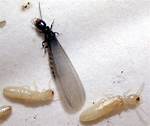
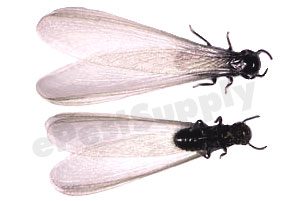
Subterranean Termite Swarmers (actual size - 1/2 inch)
They are dark brown to solid black and have rounded wing tips with all 4 wings being the same size. Subterranean termite swarmers differ from ants with their antennae being straight (not bent) and their bodies being 1 solid size. Ants have 3 body sections, with a thin neck and a thin waist.
These are subterranean termite shelter tubes. This is evidence the termites are working on this property. The termites form these tube to protect them as they work from the soil to the structure.
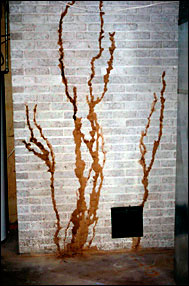
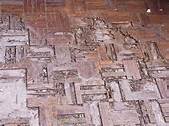
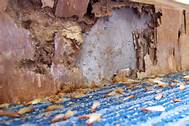
Termite Damage
As you can see it can get bad if the termites are allowed to stay as visitors in your home. Getting rid of termites is a lot more cost effective than repairing the damage.
Subterranean Termite Facts
Subterranean termites come from the Isoptera insect order and have been in existence for millions of years. There are three different forms of subterranean termites. These are the reproductive (swarmers or alates), workers and soldiers. Each of these forms, or castes, have specific characteristics. Subterranean termites get their name because they survive by living in the soil in colonies. They travel from their colonies in the soil to their food source (homes, trees, scrap wood, etc.) to feed and then return to their colony to feed it. Native subterranean termite colonies can be very small with only a few hundred, (up to around 250,000 termites), or as is the case with Formosan termites, up to 10 million. Subterranean termites can be found in every state except Alaska. Subterranean termites can do a lot of damage due to their large colonies.
Dampwood Termites
Identification
Dampwood termites are much larger then the subterranean termites and Drywood termites. The swarmers may be up to 1” in length, including their wings. The soldiers of dampwood termites have a large reddish-brown head and large multi-toothed mandibles (pincers). Dampwood termites contain various species, and are known to "swarm", in order to set up new nests, during the year from January to October.
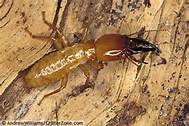
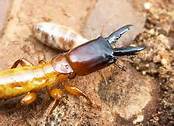
Where are they found?
Dampwood termites get their name from the damp, sometimes decaying, wood that they use to locate their colonies. Dampwood termites do not typically nest in the soil as do the subterranean termites. They will invade wood that is on the ground, especially if it is decaying.
Reproduction
A pair of winged swarmers starts a colony of dampwood termites. They find a suitable piece of wood and make a chamber in it. They produce a few eggs the first year. Colonies are usually small, but in ideal conditions dampwood termite colonies can become large.
Large winged swarmers, winged males and females, are produced for the purpose of mating and starting new colonies. These may be confused with winged ants, but the termites have straight antennae, four pairs of equal length wings and a straight sided body.
Damage
Dampwood termites do not usually have contact with the soil. They do not make tunnels like the subterranean termites. Wood that dampwood termites have damaged usually looks clean and smooth inside. They often eat across the grain, especially in wood that is decayed.
Further Information
While the dampwood termites serve a useful purpose in the wild forest, their presence in human structures causes problems. By way of prevention, control of the moisture content of wood is important. Wood-to-soil contact must be prevented in the construction of buildings. Leaking pipes can cause a lot of problems. Roof leakage, even minor seepage can be especially bad. Basements and crawl spaces are vulnerable. Chemical treatment of the wood used in construction in rainy areas is advised.
Because moisture is critical to these termites, solving moisture problems is an important part of dampwood termite control. Plumbing problems, leaks in the roof or siding, wood that is touching the ground and even rainwater drainage are all examples of situations that may need to be addressed.
After the moisture conditions have been corrected, the damaged wood can be replaced. It is sometimes necessary to use treated wood.
Termiticide treatment in the wood is sometimes necessary. Because these treatments require special tools and equipment, it is advisable to call a termite control professional. Usually getting rid of wet damaged wood and repairing any plumbing problems will take care of dampwood termites.
